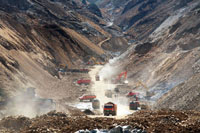On March 29, 2013, a massive avalanche of mud, rock and debris buried 83 miners camped at a mountain-top location to the east of Gyama copper-gold mine, about 70km east of Lhasa. There were no survivors. The official Chinese verdict is that the avalanche was a natural disaster, but evidence would point at a man-made disaster. Gyama mine is open-cut, and the walls of an open-pit mine are prone to collapse. Hasty mining without regard to safety is the signature here—and the miners paid the ultimate price. The world's worst mining safety record belongs to China. Thousands of Chinese miners are killed each year in mines all over China. The exact figures are not known, because details of disasters are generally obscured from the press.
Mining at Gyama is on a huge scale: the location is believed to hold reserves of five million tons of copper, 530,000 tons of molybdenum and 135 tons of gold. In August 2012, Xinhua ran a story about Gyama under the headline "A Mining Miracle" that claimed "the scene has been transformed, replaced with a panorama of lush green trees and grasslands, new roads and infrastructure, and cleaner mining facilities, giving the local people a better life." Local Tibetans, both villagers and nomads, beg to differ: they have vigorously protested against the mining operation. Gyama has been in conflict with local Tibetan villagers and nomads pretty much since it started operations. In 2009, the mining company used villagers' water because of a drought, which led to protests by the locals and the detentions of many villagers by the police.
